Response to Multiple Stressors: Enhanced Tolerance of Neoseiulus barkeri Hughes (Acari: Phytoseiidae) to Heat and Desiccation Stress through Acclimation
Abstract
1. Introduction
2. Materials and Methods
2.1. Mite Rearing and Preparation
2.2. Desiccation Acclimation
2.3. Heat Acclimation
2.4. Mortality Tests
2.5. Water Loss Test
2.6. Statistical Analysis
3. Results
3.1. Dehydration Acclimation on Mortality Rate
3.2. Heat Acclimation on Mortality Rate
3.3. Regression Analysis
4. Discussion
4.1. The Effect of Dehydration Acclimation on Mortality Rate
4.2. Effect of Heat Acclimation on Mortality Rate
4.3. Acclimation Under Combined Stress
5. Conclusions
Supplementary Materials
Author Contributions
Funding
Acknowledgments
Conflicts of Interest
References
- Tian, C.-B.; Li, Y.-Y.; Wang, X.; Fan, W.-H.; Wang, G.; Liang, J.-Y.; Wang, Z.-Y.; Liu, H. Effects of UV-B radiation on the survival, egg hatchability and transcript expression of antioxidant enzymes in a high-temperature adapted strain of Neoseiulus barkeri. Exp. Appl. Acarol. 2019, 77, 527–543. [Google Scholar] [CrossRef] [PubMed]
- Tollerup, K.E. Cold tolerance and population dynamics of Leptoglossus zonatus (Hemiptera: Coreidae). Insects 2019, 10, 351. [Google Scholar] [CrossRef] [PubMed]
- Shipp, J.L.; VanHouten, Y.M. Influence of temperature and vapor pressure deficit on survival of the predatory mite Amblyseius cucumeris (Acari: Phytoseiidae). Environ. Entomol. 1997, 26, 106–113. [Google Scholar] [CrossRef]
- Bartling, M.T.; Vilcinskas, A.; Lee, K.-Z. Sub-lethal doses of clothianidin inhibit the conditioning and biosensory abilities of the Western honeybee Apis mellifera. Insects 2019, 10, 340. [Google Scholar] [CrossRef] [PubMed]
- Gillespie, D.R.; Opit, G.; Roitberg, B. Effects of temperature and relative humidity on development, reproduction, and predation in Feltiella acarisuga (Vallot) (Diptera: Cecidomyiidae). Biol. Control 2000, 17, 132–138. [Google Scholar] [CrossRef]
- Todgham, A.E.; Stillman, J.H. Physiological responses to shifts in multiple environmental stressors: Relevance in a changing world. Integr. Comp. Biol. 2013, 53, 539–544. [Google Scholar] [CrossRef]
- Gunderson, A.R.; Armstrong, E.J.; Stillman, J.H. Multiple stressors in a changing world: The need for an improved perspective on physiological responses to the dynamic marine environment. Annu. Rev. Mar. Sci. 2016, 8, 357–377. [Google Scholar] [CrossRef]
- Kaunisto, S.; Ferguson, L.V.; Sinclair, B.J. Can we predict the effects of multiple stressors on insects in a changing climate? Curr. Opin. Insect. Sci. 2016, 17, 55–61. [Google Scholar] [CrossRef]
- Arambourou, H.; Stoks, R. Combined effects of larval exposure to a heat wave and chlorpyrifos in northern and southern populations of the damselfly Ischnura elegans. Chemosphere 2015, 128, 148–154. [Google Scholar] [CrossRef]
- Hiromori, H.; Nishigaki, J. Factor analysis of synergistic effect between the entomopathogenic fungus Metarhizium anisopliae and synthetic insecticides. Appl. Entomol. Zool. 2001, 36, 231–236. [Google Scholar] [CrossRef]
- Weintraub, P.; Palevsky, E. Evaluation of the predatory mite, Neoseiulus californicus, for spider mite control on greenhouse sweet pepper under hot arid field conditions. Exp. Appl. Acarol. 2008, 45, 29–37. [Google Scholar] [CrossRef] [PubMed]
- Le Hesran, S.; Groot, T.; Knapp, M.; Bukovinszky, T.; Forestier, T.; Dicke, M. Phenotypic variation in egg survival in the predatory mite Phytoseiulus persimilis under dry conditions. Biol. Control 2019, 130, 88–94. [Google Scholar] [CrossRef]
- Shipp, J.L.; Gillespie, T.J. Influence of temperature and water-vapor pressure deficit on survival of Frankliniella-occidentalis (Thysanoptera, Thripidae). Environ. Entomol. 1993, 22, 726–732. [Google Scholar] [CrossRef]
- Ghazy, N.A.; Suzuki, T.; Amano, H.; Ohyama, K. Effects of air temperature and water vapor pressure deficit on storage of the predatory mite Neoseiulus californicus (Acari: Phytoseiidae). Exp. Appl. Acarol. 2012, 58, 111–120. [Google Scholar] [CrossRef] [PubMed]
- Holtzer, T.O.; Archer, T.L.; Norman, J.M. Host Plant Suitability in Relation to Water Stress; John Wiley and Sons: New York, NY, USA, 1988. [Google Scholar]
- Ferro, D.N.; Southwick, E.E. Microclimates of small arthropods- Estimating humidity within the leaf boundary-layer. Environ. Entomol. 1984, 13, 926–929. [Google Scholar] [CrossRef]
- Tang, J.; Cheng, Y.; Sappington, T.W.; Jiang, X.; Zhang, L.; Luo, L. Egg hatch and survival and development of beet webworm (Lepidoptera: Crambidae) larvae at different combinations of temperature and relative humidity. J. Econ. Entomol. 2016, 109, 1603–1611. [Google Scholar] [CrossRef]
- Yang, G.; Wen, J.; Han, Y.; Hou, M. Rapid cold hardening confers a transient increase in low temperature survival in diapausing Chilo suppressalis larvae. Insects 2018, 9, 53. [Google Scholar] [CrossRef]
- Hu, J.T.; Chen, B.; Li, Z.H. Thermal plasticity is related to the hardening response of heat shock protein expression in two Bactrocera fruit flies. J. Insect Physiol. 2014, 67, 105–113. [Google Scholar] [CrossRef]
- Sjursen, H.; Bayley, M.; Holmstrup, M. Enhanced drought tolerance of a soil-dwelling springtail by pre-acclimation to a mild drought stress. J. Insect Physiol. 2001, 47, 1021–1027. [Google Scholar] [CrossRef]
- Strickler, K.; Croft, B.A. Selection for permethrin resistance in the predatory mite Amblyseius fallacis. Entomol. Exp. Appl. 1982, 31, 339–345. [Google Scholar] [CrossRef]
- Zhang, G.-H.; Li, Y.-Y.; Tian, C.-B.; Xu, Y.-J.; Zhou, H.-W.; Huang, J.; Wang, J.-J.; Liu, H. Intraspecific variations on thermal susceptibility in the predatory mite Neoseiulus barkeri Hughes (Acari: Phytoseiidae): Responding to long-term heat acclimations and frequent heat hardenings. Biol. Control 2018, 121, 208–215. [Google Scholar] [CrossRef]
- Hoffmann, A.A. Acclimation for desiccation resistance in Drosophila melanogaster and the association between acclimation responses and genetic variation. J. Insect Physiol. 1990, 36, 885–891. [Google Scholar] [CrossRef]
- Kalra, B.; Tamang, A.M.; Parkash, R. Cross-tolerance effects due to adult heat hardening, desiccation and starvation acclimation of tropical drosophilid- Zaprionus indianus. Comp. Biochem. Physiol. Part A Mol. Integr. Physiol. 2017, 209, 65–73. [Google Scholar] [CrossRef] [PubMed]
- Zhang, G.-H.; Liu, H.; Wang, J.-J.; Wang, Z.-Y. Effects of thermal stress on lipid peroxidation and antioxidant enzyme activities of the predatory mite, Neoseiulus cucumeris (Acari: Phytoseiidae). Exp. Appl. Acarol. 2014, 64, 73–85. [Google Scholar] [CrossRef] [PubMed]
- Zhang, G.H.; Li, Y.Y.; Zhang, K.J.; Wang, J.J.; Liu, Y.Q.; Liu, H. Effects of heat stress on copulation, fecundity and longevity of newly-emerged adults of the predatory mite, Neoseiulus barkeri (Acari: Phytoseiidae). Syst. Appl. Acarol. 2016, 21, 295–306. [Google Scholar] [CrossRef]
- Jafari, S.; Fathipour, Y.; Faraji, F. Temperature-dependent development of Neoseiulus barkeri (Acari: Phytoseiidae) on Tetranychus urticae (Acari: Tetranychidae) at seven constant temperatures. Insect Sci. 2012, 19, 220–228. [Google Scholar] [CrossRef]
- Williams, M.E.D.C.; Kravar-Garde, L.; Fenlon, J.S.; Sunderland, K.D. Phytoseiid mites in protected crops: The effect of humidity and food availability on egg hatch and adult life span of Iphiseius degenerans, Neoseiulus cucumeris, N. californicus and Phytoseiulus persimilis (Acari: Phytoseiidae). Exp. Appl. Acarol. 2004, 32, 1–13. [Google Scholar] [CrossRef]
- Ji, L.; Si, Y.; Xu, Q.; Wang, Z.; Chen, X.; Qiang, L. Characteristics of the high temperature heat wave in Beibei of Chongqing in 1951-2016 and its impact on the growth of flowers and trees. Chin. Agric. Sci. Bull. 2018, 34, 152–158. [Google Scholar]
- Hidalgo, K.; Mouline, K.; Mamai, W.; Foucreau, N.; Dabiré, K.R.; Bouchereau, A.; Simard, F.; Renault, D. Novel insights into the metabolic and biochemical underpinnings assisting dry-season survival in female malaria mosquitoes of the Anopheles gambiae complex. J. Insect Physiol. 2014, 70, 102–116. [Google Scholar] [CrossRef]
- Obrien, F.E.M. The control of humidity by saturated salt solutions. J. Sci. Instrum. Phys. Ind. 1948, 25, 73–76. [Google Scholar] [CrossRef]
- Gefen, E.; Ar, A. Temperature dependence of water loss rates in scorpions and its effect on the distribution of Buthotus judaicus (Buthidae) in Israel. Comp. Biochem. Physiol. Part A Mol. Integr. Physiol. 2006, 144, 58–62. [Google Scholar] [CrossRef]
- Elnitsky, M.A.; Benoit, J.B.; Denlinger, D.L.; Lee, R.E., Jr. Desiccation tolerance and drought acclimation in the Antarctic collembolan Cryptopygus antarcticus. J. Insect Physiol. 2008, 54, 1432–1439. [Google Scholar] [CrossRef]
- Adhikari, B.N.; Wall, D.H.; Adams, B.J. Effect of slow desiccation and freezing on gene transcription and stress survival of an Antarctic nematode. J. Exp. Biol. 2010, 213, 1803–1812. [Google Scholar] [CrossRef]
- Bubliy, O.A.; Kristensen, T.N.; Loeschcke, V. Stress-induced plastic responses in Drosophila simulans following exposure to combinations of temperature and humidity levels. J. Exp. Biol. 2013, 216, 4601–4607. [Google Scholar] [CrossRef]
- Benoit, J.B.; Lopez-Martinez, G.; Teets, N.M.; Phillips, S.A.; Denlinger, D.L. Responses of the bed bug, Cimex lectularius, to temperature extremes and dehydration: Levels of tolerance, rapid cold hardening and expression of heat shock proteins. Med Vet. Entomol. 2009, 23, 418–425. [Google Scholar] [CrossRef]
- Gibbs, A.G.; Chippindale, A.K.; Rose, M.R. Physiological mechanisms of evolved desiccation resistance in Drosophila melanogaster. J. Exp. Biol. 1997, 200, 1821–1832. [Google Scholar] [CrossRef]
- Folk, D.G.; Han, C.; Bradley, T.J. Water acquisition and partitioning in Drosophila melanogaster: Effects of selection for desiccation-resistance. J. Exp. Biol. 2001, 204, 3323–3331. [Google Scholar]
- Kikawada, T.; Nakahara, Y.; Kanamori, Y.; Iwata, K.-i.; Watanabe, M.; McGee, B.; Tunnacliffe, A.; Okuda, T. Dehydration-induced expression of LEA proteins in an anhydrobiotic chironomid. Biochem. Biophys. Res. Commun. 2006, 348, 56–61. [Google Scholar] [CrossRef]
- Ryabova, A.; Mukae, K.; Cherkasov, A.; Cornette, R.; Shagimardanova, E.; Sakashita, T.; Okuda, T.; Kikawada, T.; Gusev, O. Genetic background of enhanced radioresistance in an anhydrobiotic insect: Transcriptional response to ionizing radiations and desiccation. Extremophiles 2017, 21, 109–120. [Google Scholar] [CrossRef]
- Terblanche, J.S.; Sinclair, B.J.; Klok, C.J.; McFarlane, M.L.; Chown, S.L. The effects of acclimation on thermal tolerance, desiccation resistance and metabolic rate in Chirodica chalcoptera (Coleoptera: Chrysomelidae). J. Insect Physiol. 2005, 51, 1013–1023. [Google Scholar] [CrossRef]
- Kleynhans, E.; Conlong, D.E.; Terblanche, J.S. Direct and indirect effects of development temperature on adult water balance traits of Eldana saccharina (Lepidoptera: Pyralidae). J. Insect Physiol. 2014, 68, 69–75. [Google Scholar] [CrossRef]
- Leinaas, H.P.; Slabber, S.; Chown, S.L. Effects of thermal acclimation on water loss rate and tolerance in the collembolan Pogonognathellus flavescens. Physiol. Entomol. 2009, 34, 325–332. [Google Scholar] [CrossRef]
- Parkash, R.; Lambhod, C.; Singh, D. Thermal developmental plasticity affects body size and water conservation of Drosophila nepalensis from the Western Himalayas. Bull. Entomol. Res. 2014, 104, 504–516. [Google Scholar] [CrossRef]
- Bubliy, O.A.; Kristensen, T.N.; Kellermann, V.; Loeschcke, V. Plastic responses to four environmental stresses and cross-resistance in a laboratory population of Drosophila melanogaster. Funct. Ecol. 2012, 26, 245–253. [Google Scholar] [CrossRef]
- Michaud, M.R.; Benoit, J.B.; Lopez-Martinez, G.; Elnitsky, M.A.; Lee, R.E., Jr.; Denlinger, D.L. Metabolomics reveals unique and shared metabolic changes in response to heat shock, freezing and desiccation in the Antarctic midge, Belgica antarctica. J. Insect Physiol. 2008, 54, 645–655. [Google Scholar] [CrossRef]
- Karl, I.; Becker, M.; Hinzke, T.; Mielke, M.; Schiffler, M.; Fischer, K. Interactive effects of acclimation temperature and short-term stress exposure on resistance traits in the butterfly Bicyclus anynana. Physiol. Entomol. 2014, 39, 222–228. [Google Scholar] [CrossRef]
- Marron, M.T.; Markow, T.A.; Kain, K.J.; Gibbs, A.G. Effects of starvation and desiccation on energy metabolism in desert and mesic Drosophila. J. Insect Physiol. 2003, 49, 261–270. [Google Scholar] [CrossRef]
- Guohao, Z. Screening and high temperature adaptive mechanism in a heat acclimated strain of Neoseiulus Barkeri (Hughes). Ph.D. Thesis, Southwest University, Chongqing, China, 2017. [Google Scholar]
- Chen, W.; Li, D.; Zhang, M.; Zhao, Y.; Wu, W.; Zhang, G. Cloning and differential expression of five heat shock protein genes associated with thermal stress and development in the polyphagous predatory mite Neoseiulus cucumeris (Acari: Phytoseiidae). Exp. Appl. Acarol. 2015, 67, 65–85. [Google Scholar] [CrossRef]
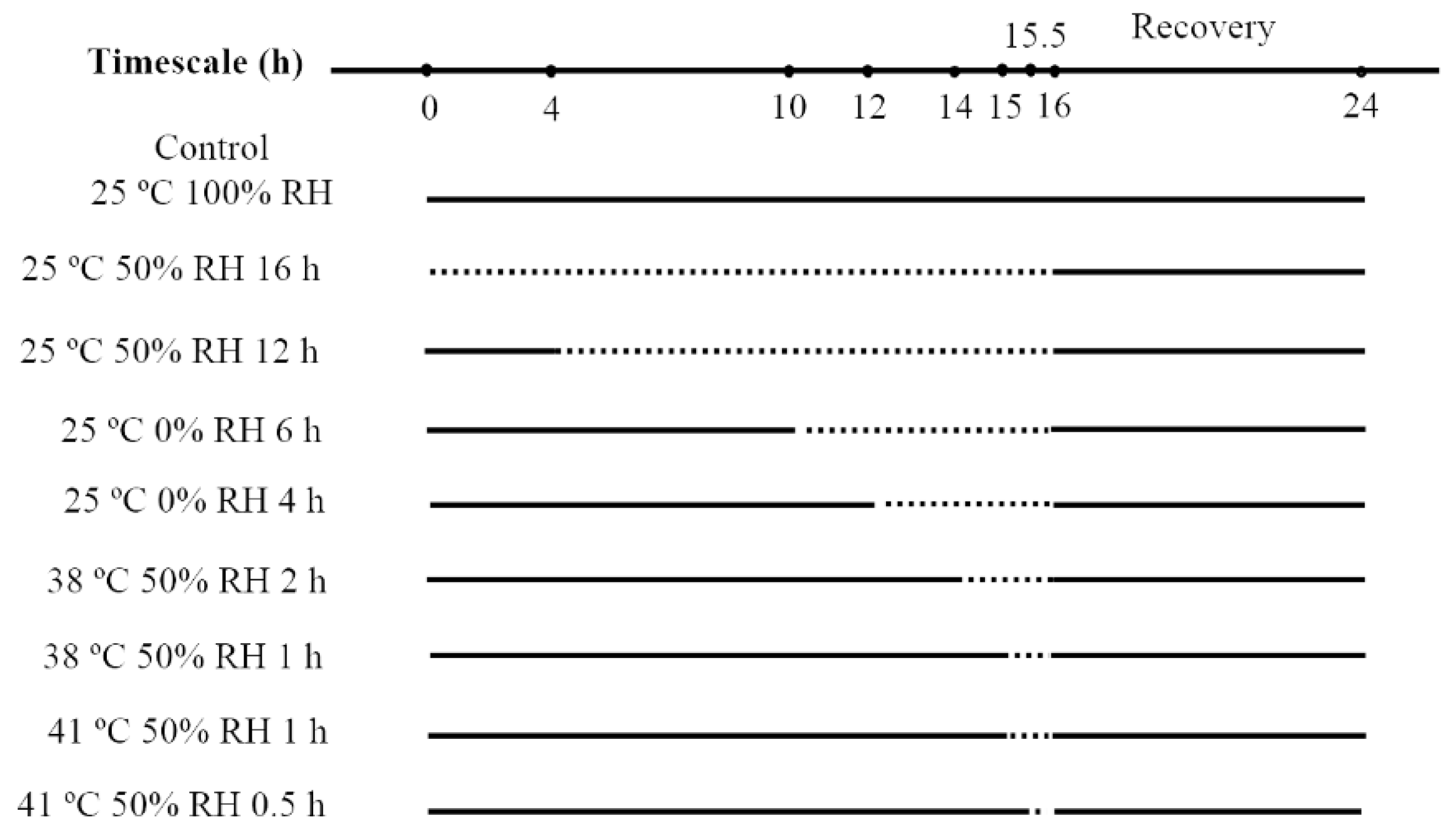
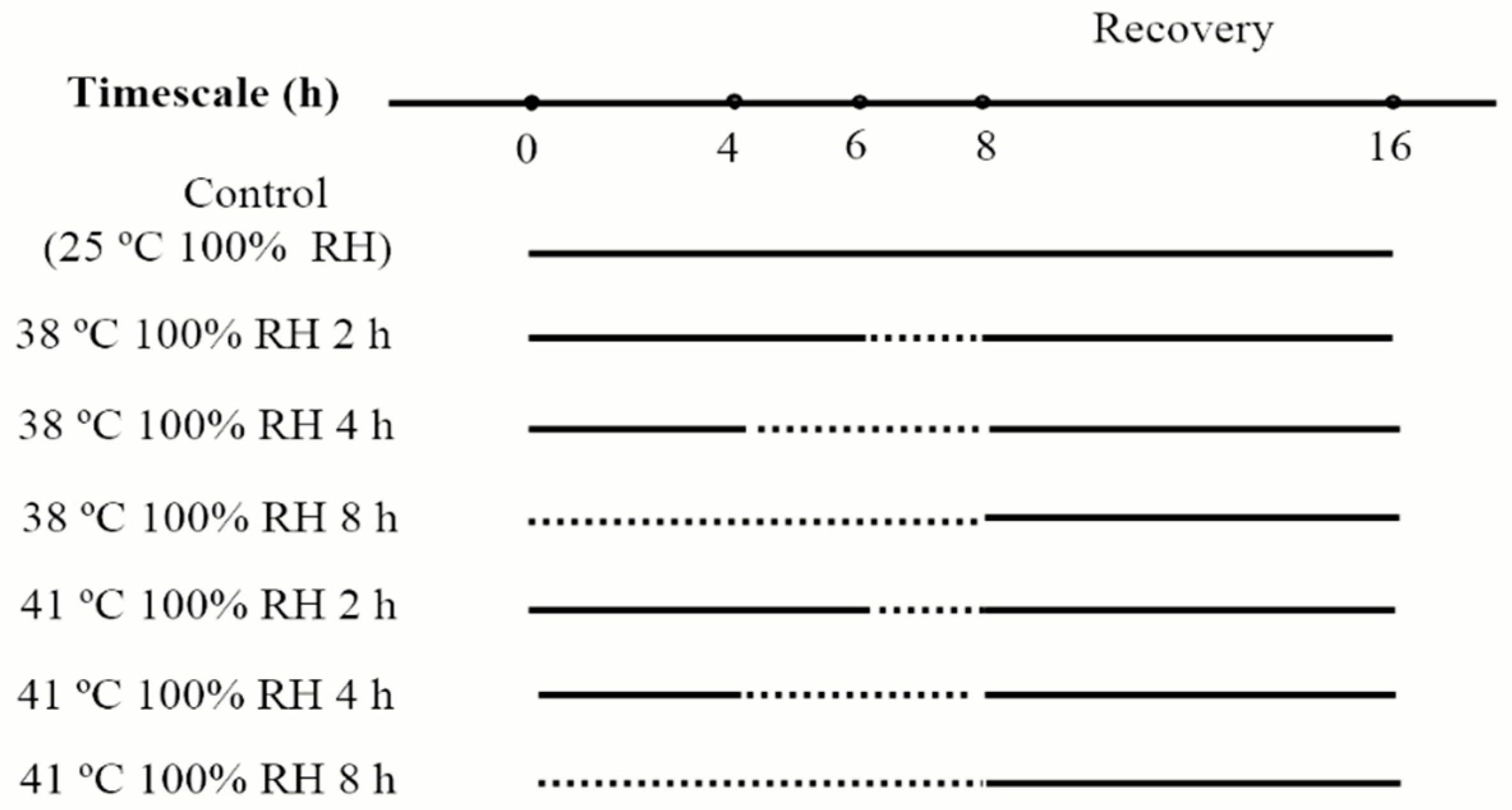
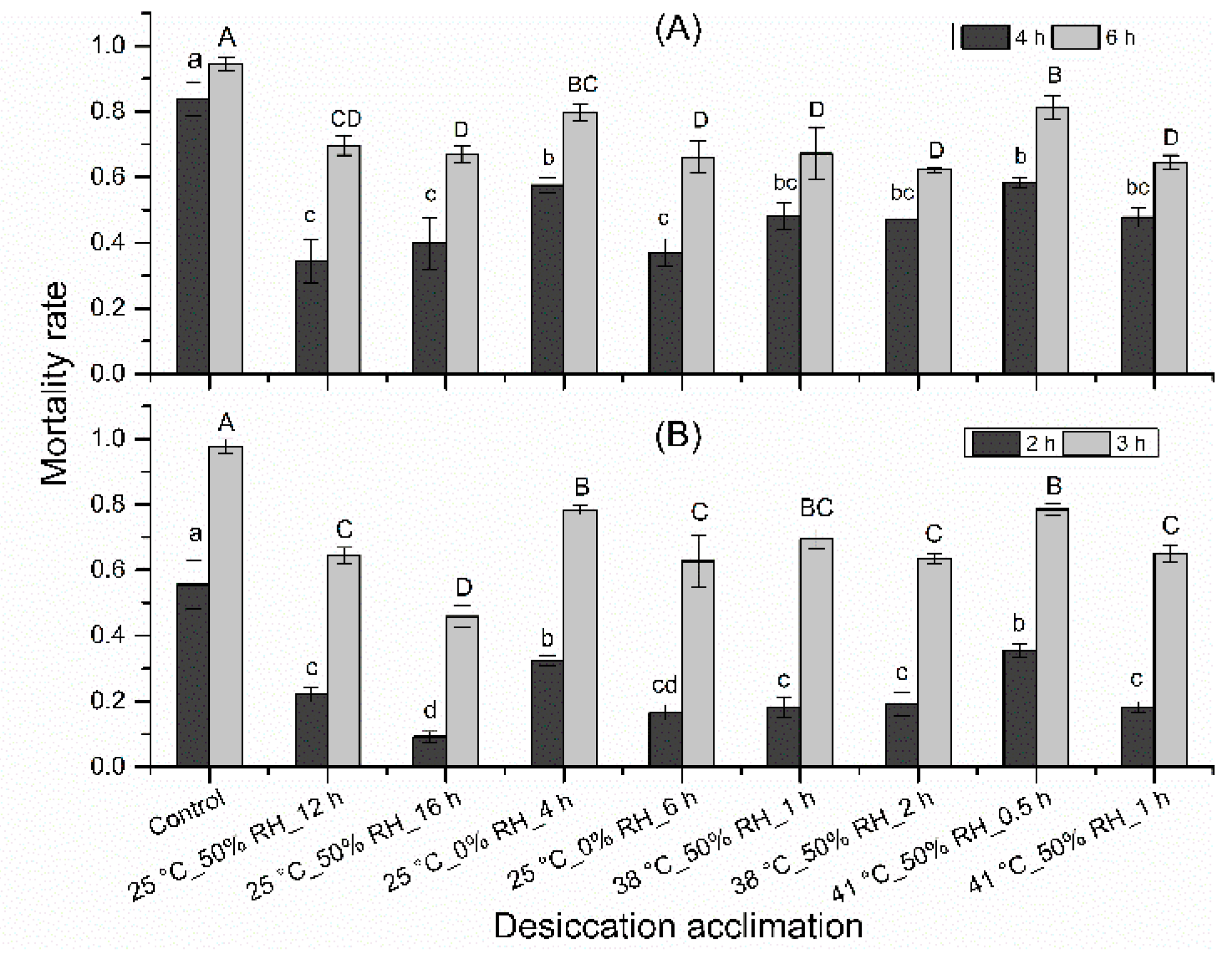
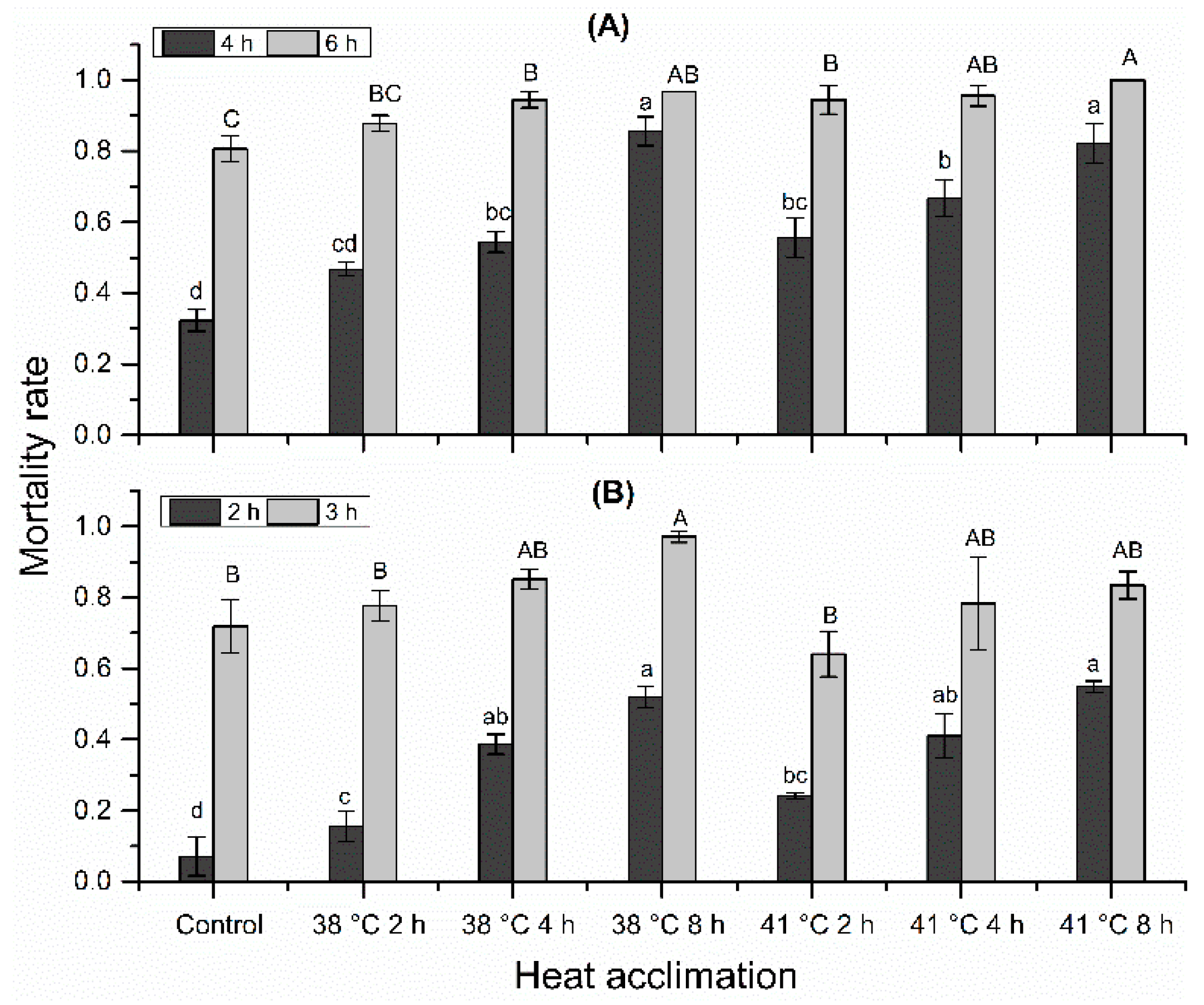
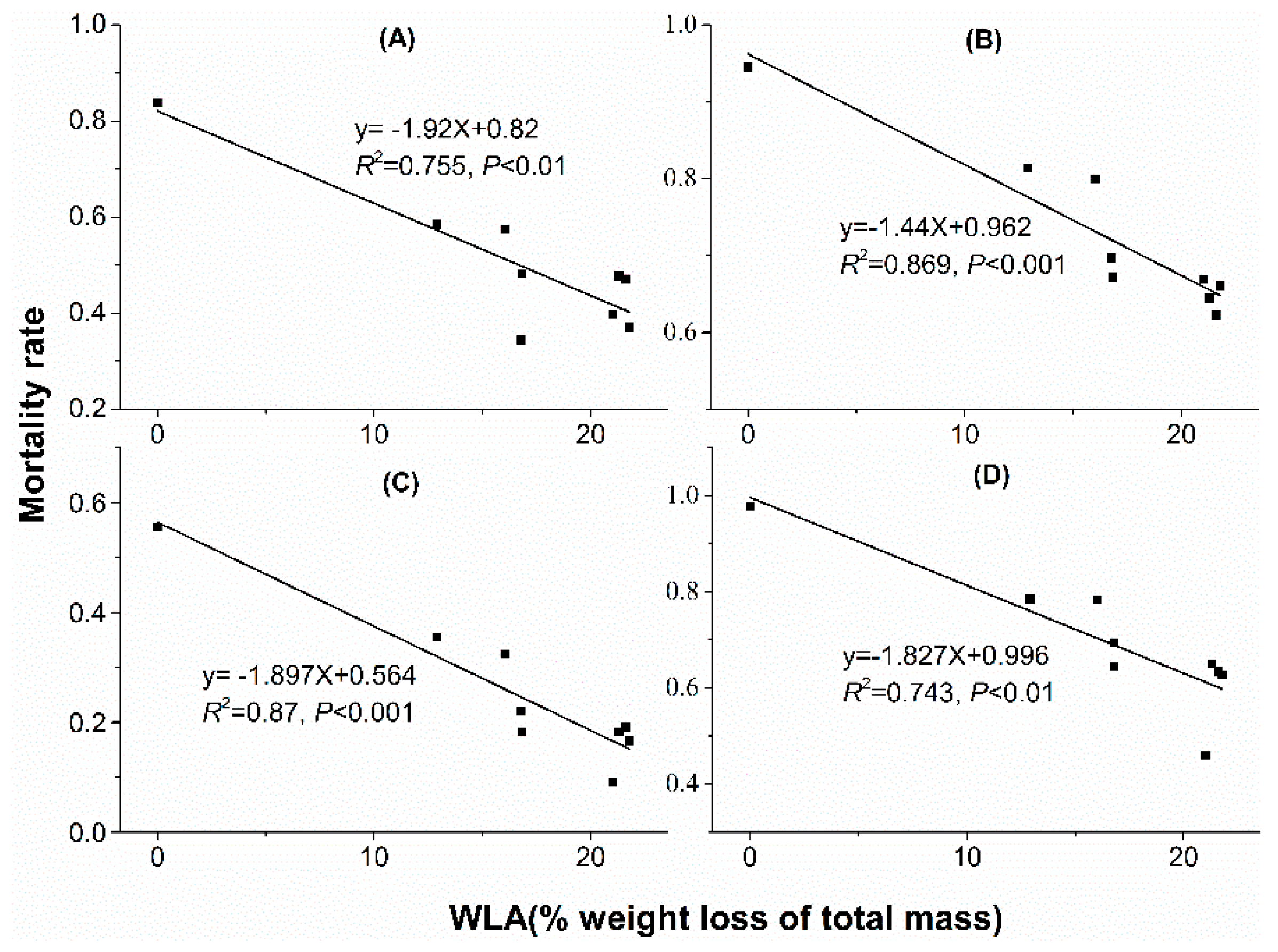
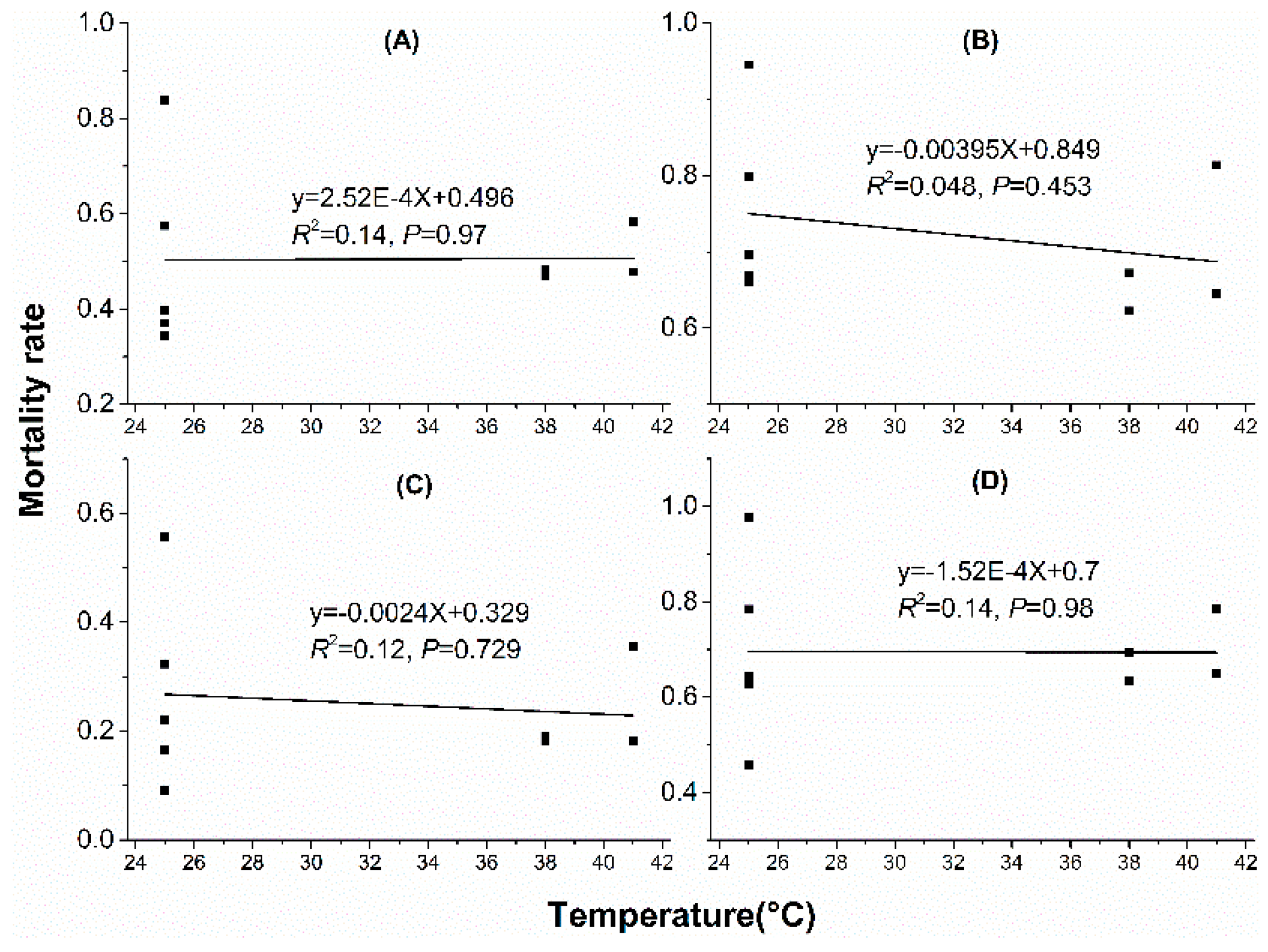

© 2019 by the authors. Licensee MDPI, Basel, Switzerland. This article is an open access article distributed under the terms and conditions of the Creative Commons Attribution (CC BY) license (http://creativecommons.org/licenses/by/4.0/).
Share and Cite
Huang, J.; Liu, M.-X.; Zhang, Y.; Kuang, Z.-Y.; Li, W.; Ge, C.-B.; Li, Y.-Y.; Liu, H. Response to Multiple Stressors: Enhanced Tolerance of Neoseiulus barkeri Hughes (Acari: Phytoseiidae) to Heat and Desiccation Stress through Acclimation. Insects 2019, 10, 449. https://doi.org/10.3390/insects10120449
Huang J, Liu M-X, Zhang Y, Kuang Z-Y, Li W, Ge C-B, Li Y-Y, Liu H. Response to Multiple Stressors: Enhanced Tolerance of Neoseiulus barkeri Hughes (Acari: Phytoseiidae) to Heat and Desiccation Stress through Acclimation. Insects. 2019; 10(12):449. https://doi.org/10.3390/insects10120449
Chicago/Turabian StyleHuang, Ji, Ming-Xiu Liu, Yang Zhang, Zai-Yin Kuang, Wei Li, Chang-Bin Ge, Ya-Ying Li, and Huai Liu. 2019. "Response to Multiple Stressors: Enhanced Tolerance of Neoseiulus barkeri Hughes (Acari: Phytoseiidae) to Heat and Desiccation Stress through Acclimation" Insects 10, no. 12: 449. https://doi.org/10.3390/insects10120449
APA StyleHuang, J., Liu, M.-X., Zhang, Y., Kuang, Z.-Y., Li, W., Ge, C.-B., Li, Y.-Y., & Liu, H. (2019). Response to Multiple Stressors: Enhanced Tolerance of Neoseiulus barkeri Hughes (Acari: Phytoseiidae) to Heat and Desiccation Stress through Acclimation. Insects, 10(12), 449. https://doi.org/10.3390/insects10120449



